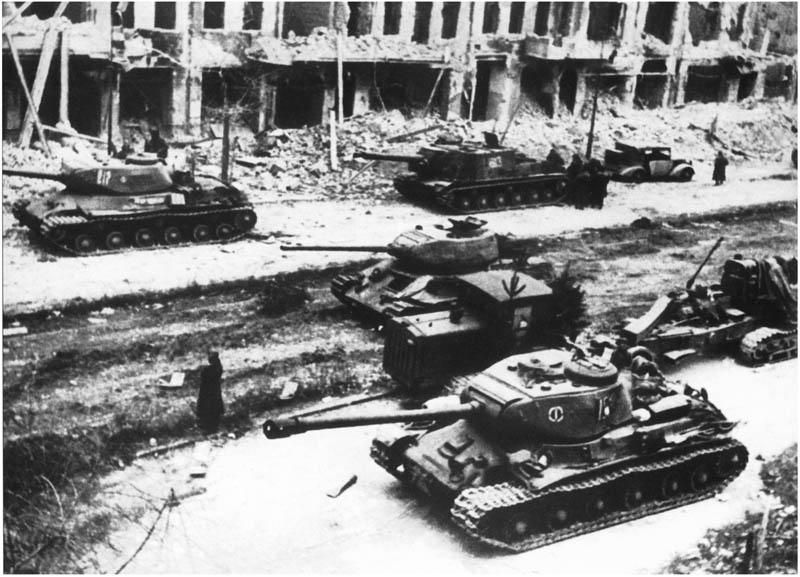Soviet Armor In Berlin 1945
Full Title: Soviet Armor in Berlin Spring 1945: IS-2 heavy tank in foreground with T-34/85s in center and back left of picture and what appears to be an ISU-152 in the back right of the photo ( Source Unknown)
By 1945 the Red Army had not only rectified many of the long existing weaknesses' plaguing it's main battle tank; the T-34 - but it had also taken delivery of increasing numbers of even heavier tanks and assault guns capable of defeating the armor on any German tank then in service. That said, the T-34 was still the Red Army's dominant tank in 1945 and for good reason.
Beginning in 1944 the Red Army had begun taking delivery of the newest model T-34s. These tanks, having received numerous upgrades, featured most prominently a new 85mm main gun, from which the tank drew its late-war designation; T-34/85. The T-34's 85mm gun represented a potent increase in firepower over the old F-34 76mm gun that was not only a smaller caliber but also could only fire its AP rounds at a 662meters/sec muzzle velocity that was hardly adequate for penetrating modern German tank armor. In comparison to the old F-34 the new 85mm gun could fire a standard AP round at a muzzle velocity reaching 899 meters/sec (or 2950feet/sec). Consequently, the T-34/85 possessed better penetrating power than did the newest Panzer IV marks, and comparable penetrating power to the Panther. Even the much-vaunted British 17-pounder gun only produced a muzzle velocity similar to the T-34/85, although the venerable 88mm cannon on the Tiger outclassed all of these weapons. Besides the new primary armament the T-34/85 also featured a redesigned heavily armored three-man turret; reducing some of the inefficiencies characterizing the old turret in the T-34/76. In addition, the T-34/85 carried thicker armor; with 75mm of sloped frontal armor on the T-34/85 vs. the sloped 60mm frontal armor on the older T-34/76. The T-34/85 also possessed one other great advantage over its foes. Because the T-34/85 was really a modification of an existing model, that tank's production meant the Soviet economy could maintain the enormous economic efficiencies necessary to crank out the massive numbers of tanks needed to propel the Red Army into Germany. Thus, not only did the T-34/85 regain parity with Germany's medium tanks in terms of hitting power it also maintained existing Soviet advantages in output. Producing the T-34/85 did not require the Soviet Union to conduct large scale retooling of factories; as needed for instance by the Germans to phase in Panther over Panzer III production, or later in the war when the Tiger II replaced the Tiger I.
Furthermore, in addition to the presence of the T-34/85 in its ranks the Red Army had also taken delivery of the Russian made answer to the Tiger I and even Tiger II. This new tank, which had trickled into select frontline units during the spring of 1944; was a brand new heavy tank; the IS-2 or JS-2 - as the I/JS derivation came from Stalin's name; Iosef/Josef Stalin. Unlike the T-34/85, the IS-2 was a new design and in fact was the long awaited replacement for the KV series of heavy tanks. Weighing 46 tons, the IS-2 featured superb protection with 160mm of frontal armor, again sloped. The IS-2 also carried even more impressive armament than armor, equipped with a 122mm cannon. Although the 122mm gun arming the IS-2 only produced a muzzle velocity reaching 747 meters/sec, it more than made up for its comparatively slow muzzle velocity with a 56-pound shell twice as heavy as the 88mm shell fired by the Tiger. With the ability to fire a powerful shell the IS-2 could engage and defeat the frontal armor on a Tiger I at ranges approaching 2000 meters; though the Tiger II, when it wasn't breaking down, proved more than capable of holding its own against the Red Army's newest heavy tank.
The 1945 era Red Army had also, and much like the German army, buttressed its burgeoning strength in tanks with a growing inventory of self-propelled guns such as the SU-76; equipped with a 76mm gun and protected by 55mm of frontal armor and a low profile. Much less common, but more dangerous, in the Red Army's ranks was the SU-100; armed with a 100mm gun and 45mm of sloped frontal armor - again on a low profile frame. During the War, the SU-100 distinguished itself as a superb anti-tank weapon; proving as effective as almost any German self-propelled and assault guns. Finally, in 1945 the Red Army could also count on ever-increasing numbers of ISU-152 series self-propelled guns, built on the IS-2 chassis, and having evolved from the SU-152, previously built upon the KV-1 chassis during 1943. Manufactured at Chelyabinsk, these potent armored fighting vehicles, powerfully armed with a 152mm howitzer, proved to be superb infantry support weapons and could more than hold their own against Germany's most commonly fielded tanks during the Second World War's final years. Nicknamed "Zveroboi" (the cat killer) for their ability to destroy even Germany's vaunted Panther and Tiger tanks, these weapons were even better suited for leveling heavily fortified strong points in the built up areas and modern cities the Red Army typically found itself fighting through in the final year of the Second World War. Along with the numerically dominant T-34/85, the IS-2 the ISU-152 provided the 1944-45 era Red Army with a triumvirate of superb armored fighting vehicles equipping its men on their march to final victory during the spring of 1945.


